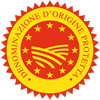Description
The Bleu d'Auvergne PDO is a marbled cheese with a non-pressed paste, uncooked, fermented and salted, produced from cow's milk with the addition of rennet and spores of Penicillium Glaucum. Production area
Production Area
The production area of Bleu d'Auvergne PDO covers the departments of Puy de Dôme and Cantal and some municipal areas of the departments of Haute-Loire, Aveyron, Lot, Corrèze and Lozère, in the regions of Auvergne, Midi-Pyrenees, Limousin and Languedoc-Roussillon.
Production Method
The milk used for the production is coagulated only with the addition of rennet. Once obtained the curd, the mass is cut, mixed and put into the mould. Later, after whey dripping, the paste is upturned, salted and pricked. This ventilation system enables the so-called bleu to develop in the mass. The ripening phase takes place in humid, fresh and well-aerated cellars and lasts a minimum of four weeks. Already after three weeks, the penicillium develops inside the cheese and gives to it the traditional blue veining. Fresh cheese and cheese undergoing the maturing process may not be conserved under a modified atmosphere.
Appearance and Flavour
The paste of Bleu d'Auvergne PDO is tender, humid and friable, with regular marbling and a sharpish taste. The piquant flavour of moulds is combined with the salt, of which the paste is rich.
History
The history of Bleu d'Auvergne PDO is the result of a long tradition. Indeed, the cheese appeared in the middle of the 19th century. At that time, the companies in the area of Clermont-Ferrand produced country cheeses of different types, rather difficult to sell. Due to an unexpected chance, the producers understood that some cheeses became blue in the cellars. The cheeses with this peculiar colour could be distinguished from the others thanks to their strong and tasteful flavour. Antoine Roussel attempted to produce spontaneously this transformation and understood that the rye bread, conserved in the drawer together with cheese, became also blue. So he guessed the importance to gather the bread's moulds and to cover the cheeses with them, and later to prick them so that moulds could penetrate into the cheese.
Gastronomy
Bleu d'Auvergne PDO does not need any special attention to be conserved. Indeed, it can be easily conserved for two weeks wrapped into a film or a foil in the least cold compartment of the refrigerator. Bleu d'Auvergne PDO can be tasted as a table cheese at the end of meals, but it can also be used to prepare different dishes. It is ideal to accompany chicory, walnuts and raw mushrooms, but it is also perfect to season piquant and flavourful pasta dishes. It is ideal with suave wines, warm and sometimes honeyed, with an intense scent, like Jurançon or Sauternes, but also bodied red wines like Madiran, Gaillac, Cahors or Bourgogne and Côtes-du-Rhône.
Marketing
The product is sold only as Bleu d'Auvergne PDO. It is marketed whole, in portions, in slices and prepacked.
Distinctive Features
Bleu d'Auvergne PDO is one of the greatest French marbled cheeses. It is commonly defined as the cousin of Roquefort, but it is produced with cow's milk in an area characterized by volcanic and granitic lands, which are ideal for pasture, as they are rich in minerals.






